Football Rules and Regulations
Football is one of the world's most popular outdoor games. There are 17 laws that govern how the game is to be played so that it is fair to all players taking part in a football game.
The most basic rule is that a player needs to move the ball towards the opponents’ goal line using any body part except the hands and arms. The Laws of the Game were created in 1863 and were updated with time. But what are the main football rules and regulations?
Objective of a Football Match
The main objective in a football match is to score more goals than the opponent team. Whichever team has more goals at the end of 90 minutes is declared the winner of the football match.
If both teams score an equal number of goals, then either a draw is declared or the game goes into extra time or a penalty shootout, depending on the competition.
Rules for Ball and Players’ Equipment Used
-
A football game is played using a spherical ball, known as the football (or soccer ball), of 68 - 70 cm (27-28 inch) in circumference and weighs between 410 - 450 g.
-
The balls are usually made from leather and filled with air to an appropriate pressure for playing.
-
Every player must wear appropriate equipment including a jersey, shorts, footwear, and long socks with protective guards for a standard football game.
Rules for Football Players
It is one of the most crucial football rules for the game.
-
A football match has two teams playing against each other.
-
The number of players in each team should be a minimum of 7 and must not exceed 11.
-
Four categories of players are there in a football match. Goalkeeper, defenders, midfielders, and forwards.
-
There must be one player designated as a goalkeeper in each team. If a goalkeeper is unavailable/suspended, any position player can become the designated goalkeeper.
-
Each team is led by a captain, whose one official responsibility is to represent the team at the coin toss before the kick-off or penalty kicks.
-
Winning the coin toss means your team gets to choose the initial direction of play. The direction of both teams switches after half time before the second half starts. The team that loses the toss does the first kick-off and starts.
Player Formation in Football
The player formation is not exactly one of the football rules, it is a football strategy that constitutes how players in a team position themselves in relation to each other on the football field.
-
A player's position in a formation typically defines whether a player has a more defensive or attacking role.
-
Formations are described by usually three or four numbers in order to denote how many players are in each row of the formation, from defense to offense. For example, the "4–5–1" formation has four defenders, five midfielders, and a single forward.
-
Different formations are used depending on how a team wishes to play in a football match. A team may switch formations between or during the game for tactical reasons.
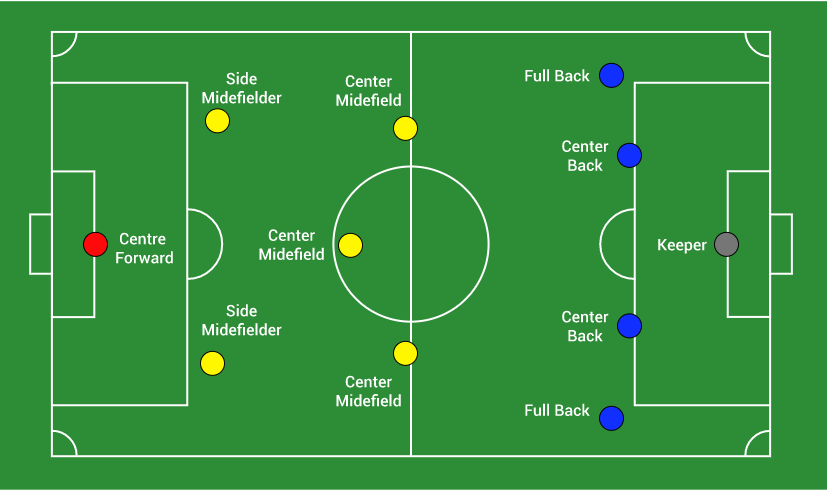
Number of Substitutions in Football
Similar to the player formation, the use of substitutions in football is also a football tactic.
-
A number of players may be replaced by substitutes during the game. A maximum of three or five substitutions are permitted in most of the competitive football games.
-
Common reasons for a substitution include injury, tiredness, ineffectiveness, or a tactical switch. A player who has been substituted can not take part in the match again.
Football Match Time
One of the basic football rules is the football match time.
-
A football match (game) consists of two halves. The normal duration or playing time of each half is 45 minutes plus any extra time to compensate for player substitution stoppages or injuries during the half.
-
A football match (game) consists of two halves. The normal duration or playing time of each half is 45 minutes plus any extra time to compensate for player substitution stoppages or injuries during the half.
-
Overtime is added to a match when no winner has been determined by the end of regular time. The overtime period is of 30 mins (2 halves of 15 mins each) duration.
Disciplinary Cards in Football
There are two disciplinary cards in football: Red and Yellow cards. These colors were first introduced at the 1970 Football World Cup and are in use ever since.
-
Yellow means the player is only cautioned and given a warning
-
Red card means dismissal from the game for that particular player
-
Two yellow cards in the same match for one player also result in the player’s dismissal

Disciplinary Cards in Football
Football Referees and Officials
A football game is officiated by a referee, who has full authority to enforce the football rules and Laws of the Game during the match and whose decisions are final. The referee is assisted by two assistant referees (also known as linesmen) and a fourth official who assists the referee and may replace another official if needed.
Goal Line Technology and Use of VAR
Nowadays, technology is becoming a big part of the football rules and regulations.
-
Goal Line Technology is used to determine if the whole ball has crossed the goal line, thereby deciding whether a goal has been scored or not. A signal is transmitted to the referee’s watch, indicating whether or not the ball has crossed the goal line.
-
Video assistant referees (VAR) have been introduced to assist the officials in football matches and correct mistakes made by the on-field referee. After watching video replays on a monitor on the side of the pitch, the referee can either overturn his decision, or stick with his initial decision
-
VAR can be used to review four types of decisions: goal check and whether there was any foul during the buildup, direct red card decisions, penalty decisions and mistaken player identity when awarding a card.
Football Ground Measurement
Football ground size is one of the key football rules. While grass is the typical playing surface, football can also be played on artificial turf or on surfaces with dirt.
-
A standard football ground measurement is 105 x 68 meters. Various football ground sizes exist but the size can never be smaller than the certified length and breadth by the international football body.
-
The length of the field, called ‘the touchline’ must be 90 to 120 meters while the width, known as the “goal lineâ€, should be between 45 to 90 meters. Goals are located in the center of each goal line and are 7.32 meter wide.
-
The football pitch is split with a half-way line and a center circle with a radius of 9.15 meters.
-
Other crucial areas of a football field include the penalty area, the goal area and the penalty spots. The goal area is a rectangular zone centered on the goal starting 5.5 meter out from both goal posts and extending 5.5 meter into the pitch.
-
The penalty area is the larger section around the goal area that is 16.5 m from the posts and 16.5 m out. For penalty kicks, the penalty spot is centered at 11 m from the goal line. The corner arc radius is set at 1 meter.
Football Ground
Below is the standard football ground diagram.
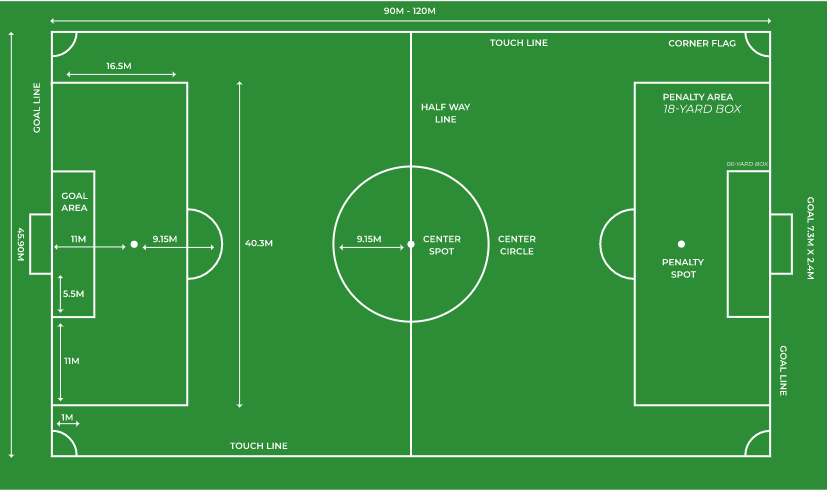
Starting or Restarting a Game
A football game starts/resumes with a kick-off from the center spot at the start of each half and after the scoring of every goal. The team that concedes a goal restarts the play. Before the restart, all players should be in their own team's half.
Football Fair Play Rules
-
Touching the Ball
Except for the goalkeeper, all the outfield players are allowed to only use their feet, chest, or head to play the ball. The goalkeeper can use his/her hands but only inside the designated goal area.
-
Fouls and Disciplinary Cards
Fouls and misconduct are an important part of the football rules and regulations. Fouls made by players during a football game usually results in disciplinary action.
-
The referee uses the two caution cards (yellow and red) for the players involved. A yellow card is shown to caution the player for the foul committed.
-
Serious fouls may receive a direct red card. The concerned player is suspended from the game and the team plays with one less player for the remainder of the match.
-
-
Free Kicks Rule in Football Match
Free kicks are awarded following a foul or misconduct during the football match.
-
A free kick (either direct or indirect) is taken from a stationary position from the place of the foul. Direct free kicks allow a direct shot at goal.
-
An indirect free kick means the ball must make contact with at least one other player before scoring a goal.
-
-
Penalty Kicks During A Football Match
Penalty kick is a type of free kick given due a serious foul committed inside the goal area. Only the opposing team’s goalkeeper is allowed to defend a penalty kick.
-
A penalty kick is taken from the penalty spot marked on the football field.
-
Only the kicker and the defending team's goalkeeper are allowed to be within the penalty area. All other players must be outside the penalty area, and behind the penalty spot.
-
The goalkeeper is allowed to move before the ball is kicked but must have both feet on the goal line at the moment the kick is taken.
-
The ball is in play once it is kicked, and other players may enter the penalty area to take advantage or save.
-
-
Offside Rule in Football
The offside rule is one of the complex football rules. It is called when an attacking player is in front of the last defender when the pass is played through to them. The offside area is designed to discourage players from staying around the opponent’s goal waiting for a pass to score.
-
To be onside, one must be behind the last defender when the ball is played to them. If the player is in front of that last defender, then he/she is deemed to be offside and a free kick to the defending team is awarded.
-
A player cannot be caught offside in their own half. If the ball is played backwards and the player is in front of the last defender, then he/she is deemed to be not offside.
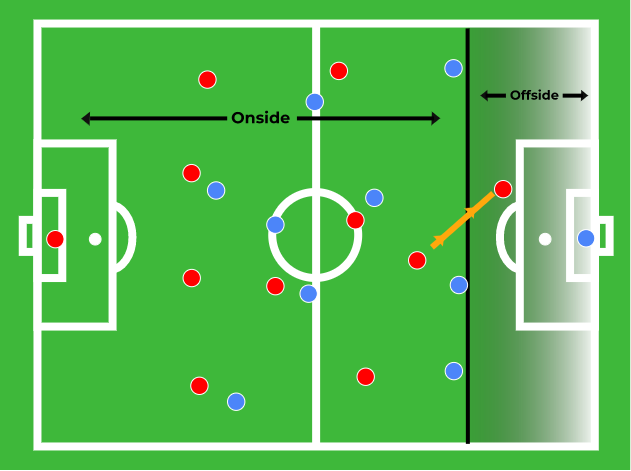
Offside Rule In Football
-
-
Ball In or Out of Play
-
The ball is in play when it is inside the field of play and the referee has not stopped play. If the ball rebounds off a goalpost, corner flag, or the referees and remains in the field, it is still in play.
-
The ball is out of play when it has completely crossed the touchlines or the goal lines, whether in air or on ground.
-
-
Football Throw-in Rule
If the ball goes out of play past the touchlines, it results in a throw-in. A throw-in is awarded to the opponents of the player who last touched the ball, deliberately or accidentally. A throw-in is taken by hand.
-
Goal-Kick Rule In Football
A goal-kick is awarded to the defending team when the ball crosses its goal line, a goal has not been scored, and the last player touch was from the opposition. Although it is generally the goalkeeper, any player may take the goal kick, placing the ball anywhere in the goal area.
-
Corner-Kick Rule In Football
A corner-kick is awarded to the attacking team when the opposition is last to touch the ball and the ball crosses the goal line without a goal being scored. The attacking team restarts play by placing the ball in one of the 2 corners nearest to where it crossed the goal line.

-16593471127910.png?v=1659347113)
-16593471201810.png?v=1659347120)
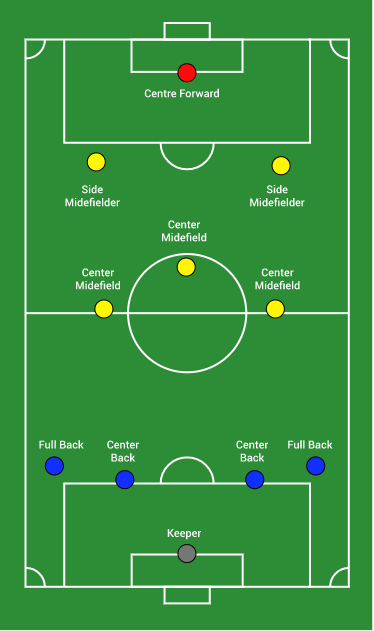
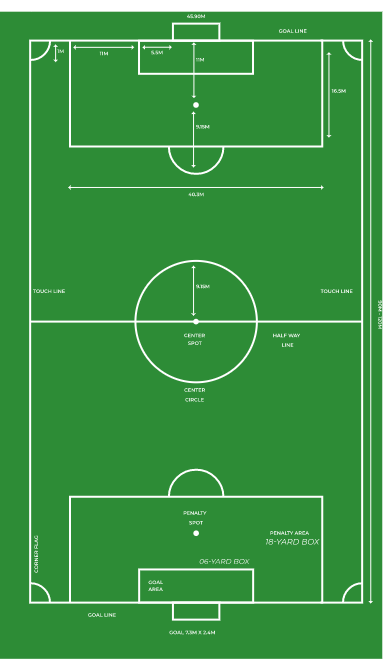
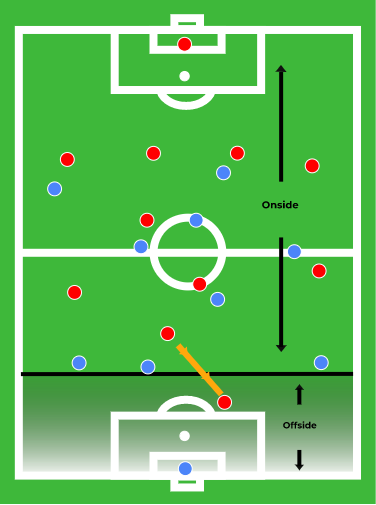
-16622018674581.png?v=1662201868)









-16909143862904.png?v=1690914386)



